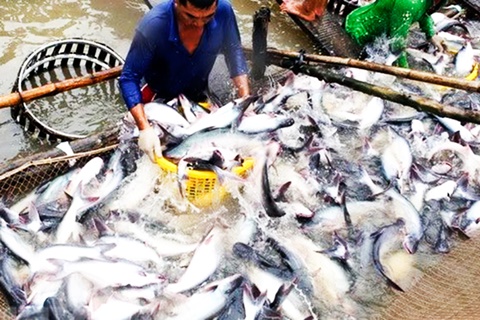Assoc. Prof. Dr. Nguyen Thi My Huong - Head of Department of Post-Harvest Technology, Faculty of Food Technology, Nha Trang University has just successfully implemented a research project about obtaining hydrolyzed protein from pangasius catfish’s head and bones and its application in fish sauce production. The result of the project is a scientific basis for the implementation of fish sauce production from pangasius catfish by-products on an industrial scale, meeting the increasing consumption of fish sauce by consumers.

Utilizing by-products ...
Assoc. Prof. Dr. Nguyen Thi My Huong said that according to the report of Vietnam Association of Seafood Exporters and Producers, pangasius export turnover reached approximately US$ 2 billion and raw pangasius yield reached about 1.4 million tons in 2019. Pangasius processing industry has created a huge amount of by-products including: head, bone, viscera, skin, fins, trim meat ... which are easily polluting the environment. Meanwhile, the fish head and bones contain a rich source of protein, which can be utilized to produce hydrolyzed protein. Hydrolyzed protein obtained with high nutrient content can be applied in food field such as fish sauce production.
Currently, the demand for fish sauce is very large, but in recent years, the yield of anchovy and scad has been decreasing, making the source of fish materials for fish sauce production reduced. This leads to production expenses for fish sauce are gradually higher. Meanwhile, the amount of pangasius’ head and bones discharged from pangasius processing is very large, much cheaper than anchovy and scad. On the other hand, the production of anchovy fish sauce by the traditional method takes time, usually about 12 months. On the contrary, the addition of protease enzyme to hydrolyze the protein in pangasius’ head and bones will speed up the hydrolysis process, which shortens the production time of fish sauce compared to the traditional method.
From that fact, the research project "Acquisition of hydrolyzed protein from pangasius’ head and its application in fish sauce production" has been carried out by Assoc. Prof. Dr. Nguyen Thi My Huong. The results of the project showed that the combination of two enzymes Alcalase and Flavourzyme to hydrolyze pangasius by-products created a hydrolyzed protein with good organoleptic and chemical quality, which can absolutely be used in fish sauce production. The hydrolyzed protein from pangasius by-products is supplemented with salt at a rate of 25%, then it is incubated in brined (salt-pickled) anchovy container in natural conditions for 8 weeks to create a delicious taste and typical color for the fish sauce.
... to make premium fish sauce
The research result showed that fish sauce produced from pangasius by-products met the organoleptic, chemical and microbiological criteria according to Vietnamese standard TCVN 5107-2018. The fish sauce has puce color, typical fragrance, no strange smell, sweet taste of protein, purity, no cloudiness and no impurities. Total nitrogen content in fish sauce is 25.69g/l, amino acid nitrogen content is 14.38g/l, ammonia nitrogen content is 2.35g/l. The fish sauce has a high nutrient value with a total amino acid content of 9.48g/100ml; in which the content of irreplaceable amino acids is 5.39g/100ml. According to Vietnamese standard TCVN 5107-2003, fish sauce produced from pangasius by-products is classified top-ranking.
According to the Evaluation Committee of Nha Trang University, the use of pangasius by-products in fish sauce production not only contributes to limiting environmental pollution but also improving the efficiency of using by-products after processing, creating a new type of fish sauce product with high value. The success of the project creates opportunities for businesses and companies specialized in pangasius processing in particular and fish processing in general to take advantage of fish by-products to develop fish sauce production, diversify fish sauce products on the market, contributing to increasing profits for businesses and developing sustainable fisheries industry.